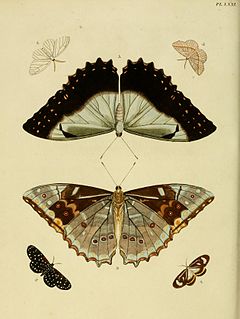
Dioptis cyma is a moth of the family Notodontidae first described by Jacob Hübner in 1818. It is found in Peru, Brazil and French Guiana.

Dioptinae is a subfamily of the moth family Notodontidae.

Dioptis is a genus of moths of the family Notodontidae. It consists of the following species:
Dioptis chloris is a moth of the family Notodontidae first described by Herbert Druce in 1893. It is found in southern Ecuador and Peru.
Dioptis butes is a moth of the family Notodontidae first described by Herbert Druce in 1885. It is found from Costa Rica north to Belize and Veracruz in Mexico.
Dioptis longipennis is a moth of the family Notodontidae first described by William Schaus in 1913. It is found in Costa Rica, Panama and Nicaragua.
Dioptis pellucida is a moth of the family Notodontidae first described by William Warren in 1901. It is found in Colombia.
Dioptis vacuata is a moth of the family Notodontidae first described by William Warren in 1905. It is found in Panama.
Dioptis obliquaria is a moth of the family Notodontidae first described by William Warren in 1905. It is found in southeastern Peru.
Dioptis charila is a moth of the family Notodontidae first described by Herbert Druce in 1893. It is found across northern South America and south into the Amazon basin, at least as far as Loreto, Peru.
Dioptis fatima is a moth of the family Notodontidae first described by Heinrich Benno Möschler in 1877. It is found in Brazil, Venezuela, Guyana, Suriname, French Guiana and Peru.
Dioptis indentata is a moth of the family Notodontidae first described by Hering in 1925. It is found in Brazil.
Dioptis aeliana is a moth of the family Notodontidae first described by Henry Walter Bates in 1862. It is found in lowland sites in Amazonian Brazil.
Dioptis areolata is a moth of the family Notodontidae first described by Francis Walker in 1854. It is found in Brazil and Venezuela.
Dioptis curvifascia is a moth of the family Notodontidae first described by Louis Beethoven Prout in 1918. It is found in Brazil and Peru.
Dioptis incerta is a moth of the family Notodontidae first described by Hering in 1925. It is found in Peru.
Dioptis leucothyris is a moth of the family Notodontidae first described by Arthur Gardiner Butler in 1876. It is found in Brazil and Peru.

Dioptis meon is a moth of the family Notodontidae first described by Pieter Cramer in 1775. It is found in Guyana and Suriname.
Dioptis onega is a moth of the family Notodontidae first described by Henry Walter Bates in 1862. It is found in Brazil.
Dioptis trailii is a moth of the family Notodontidae first described by Arthur Gardiner Butler in 1877. It occurs at localities throughout the upper Amazon basin of Brazil and Peru, and is known from at least one locality in central Venezuela.

